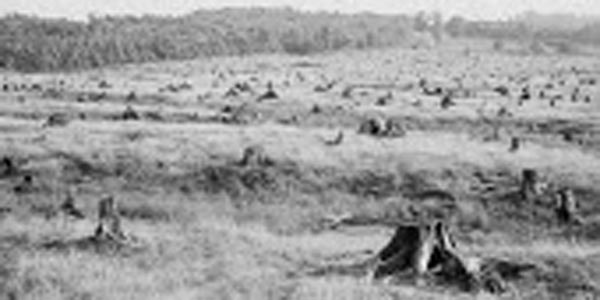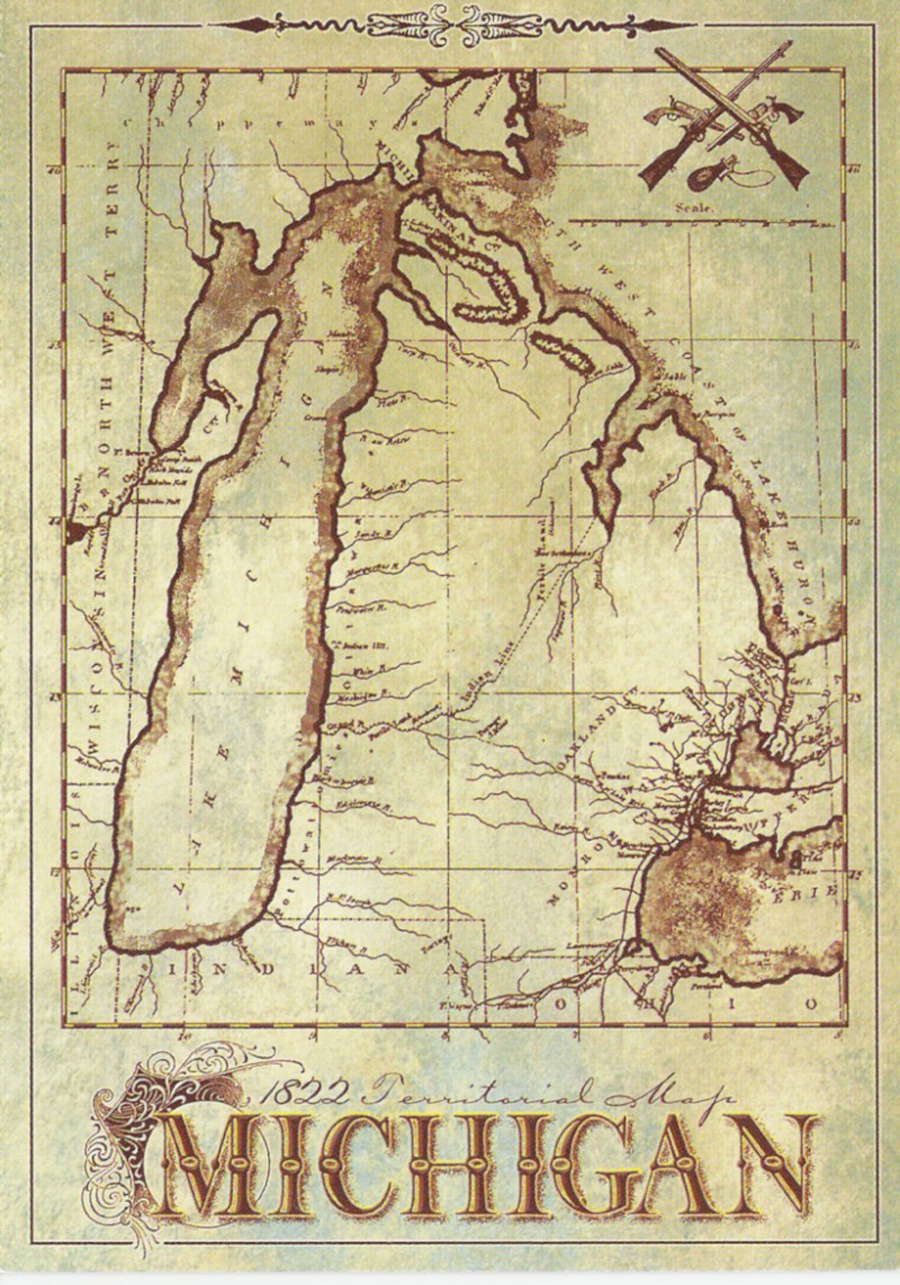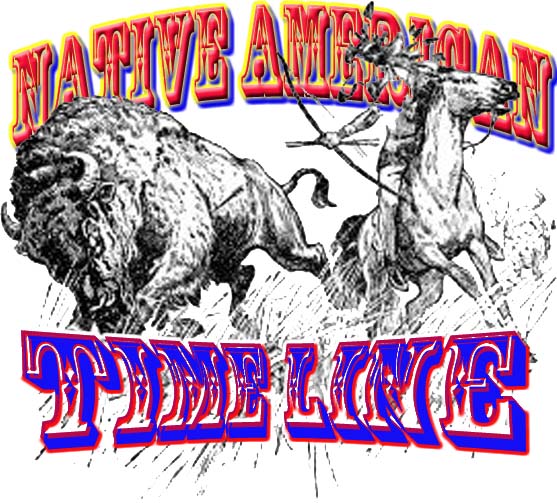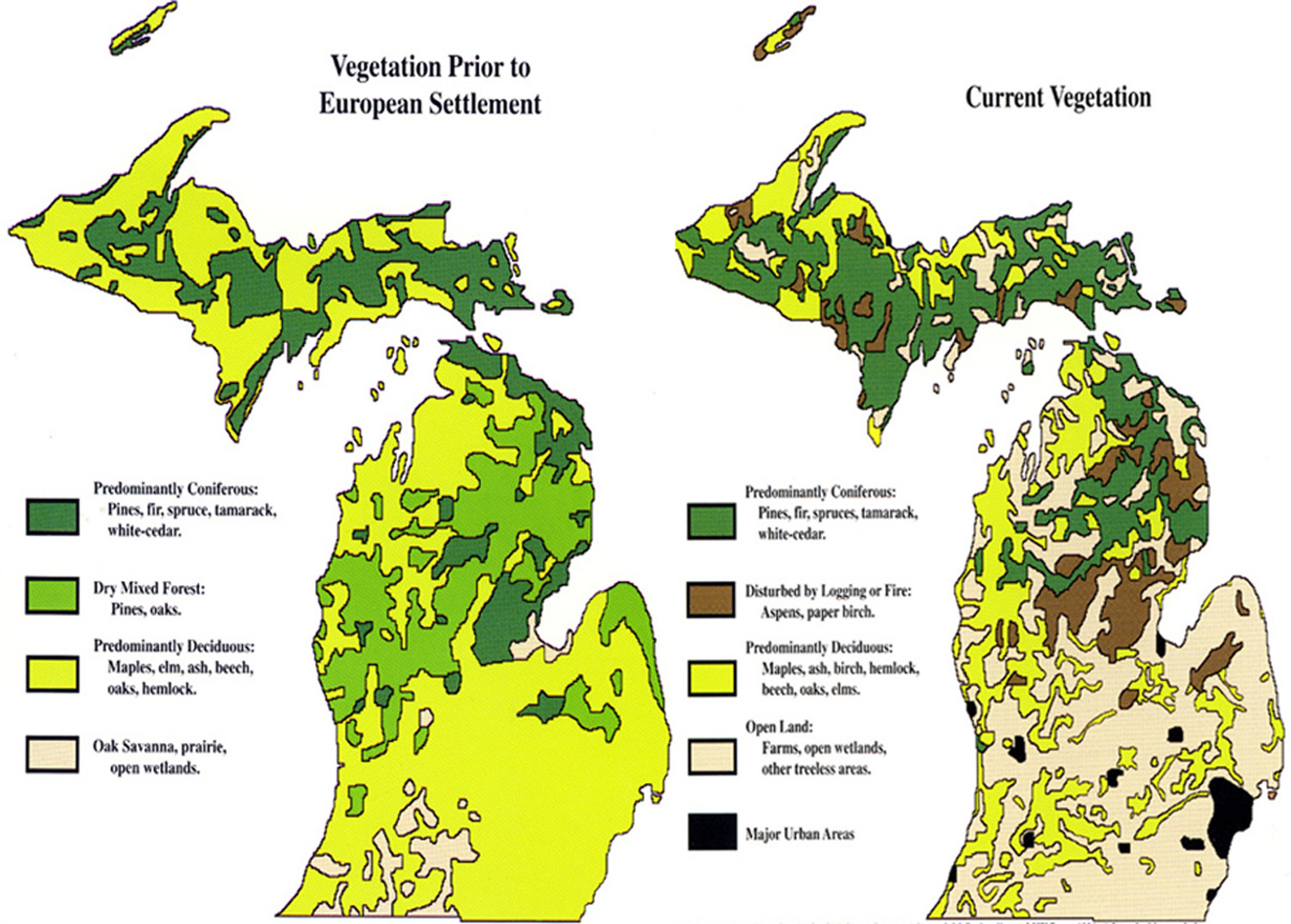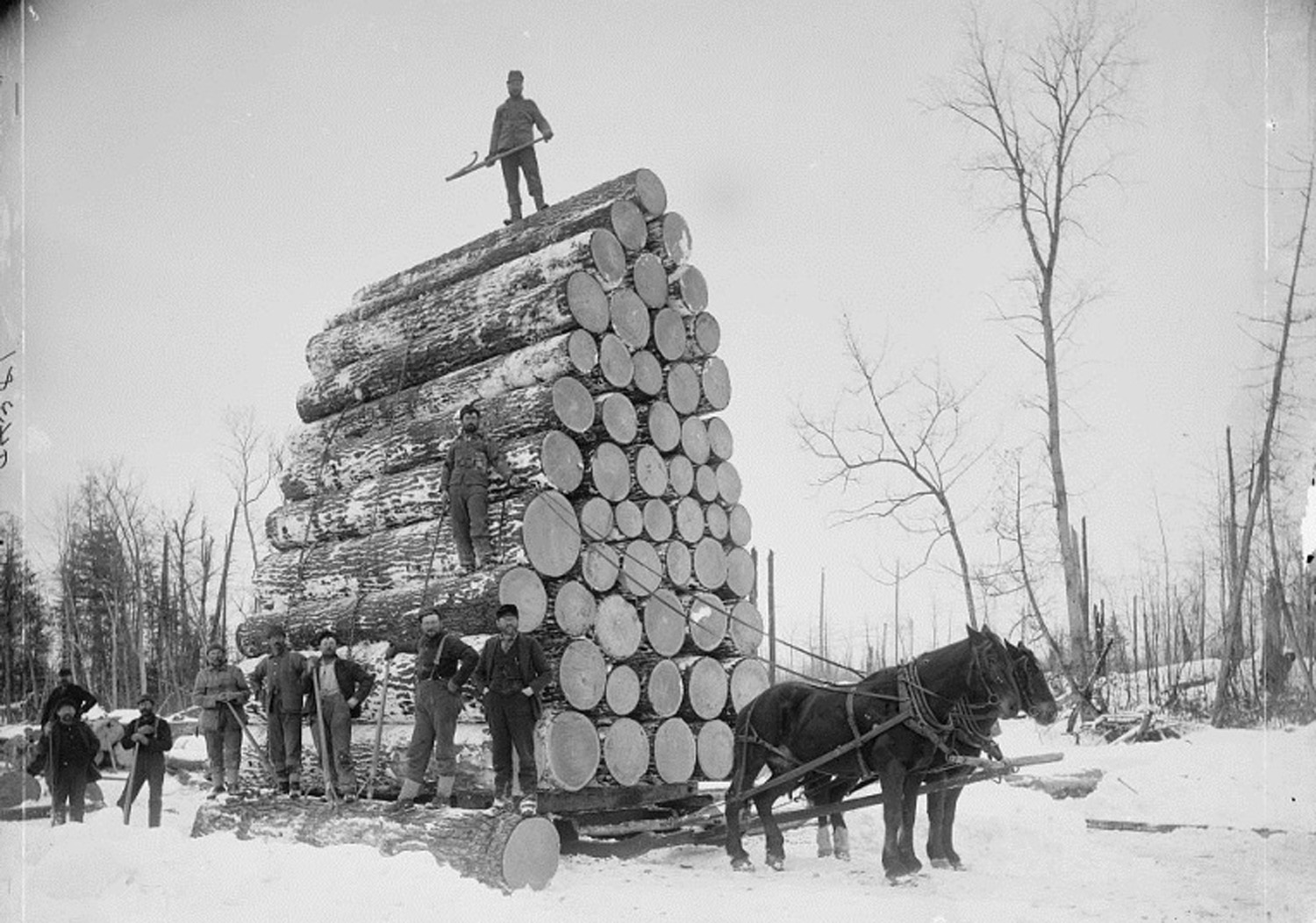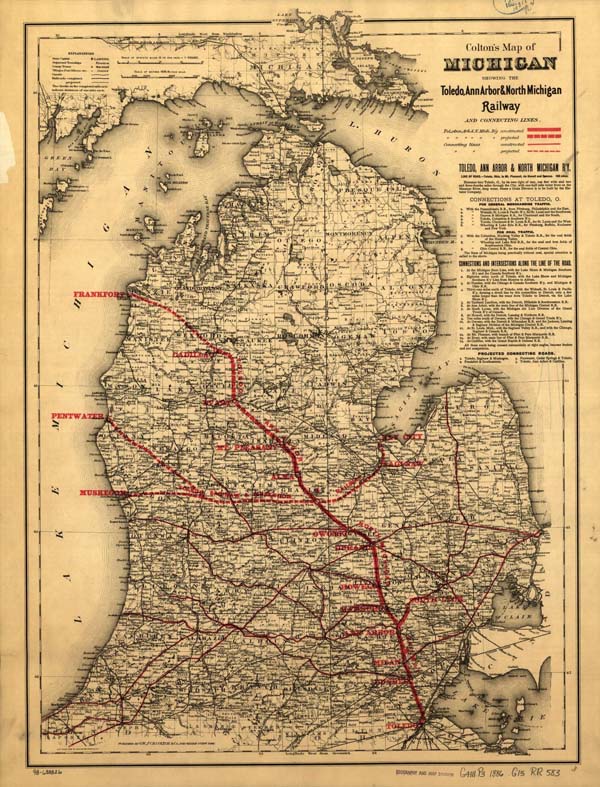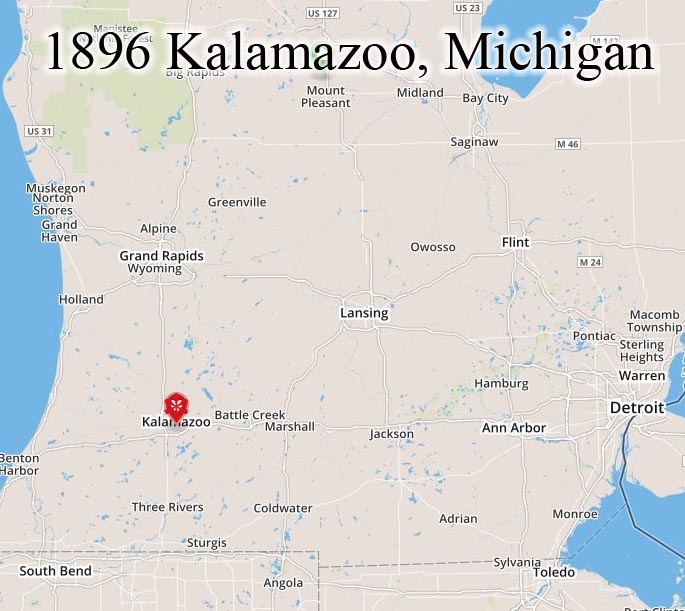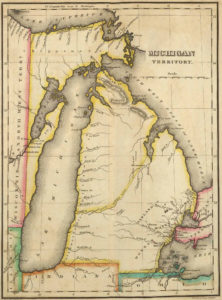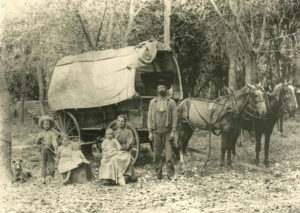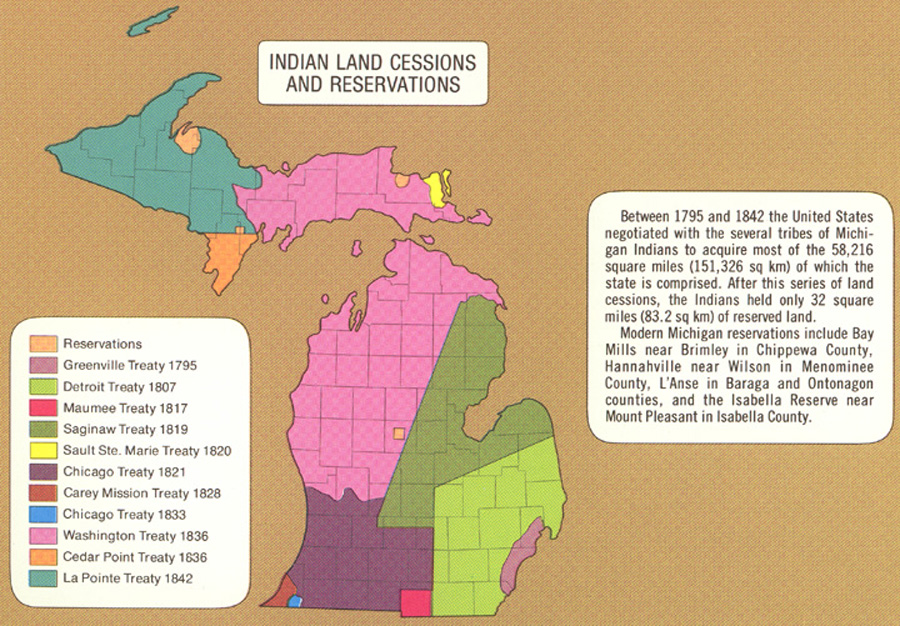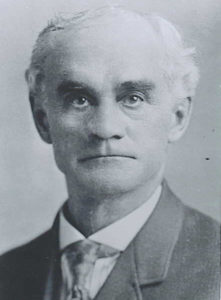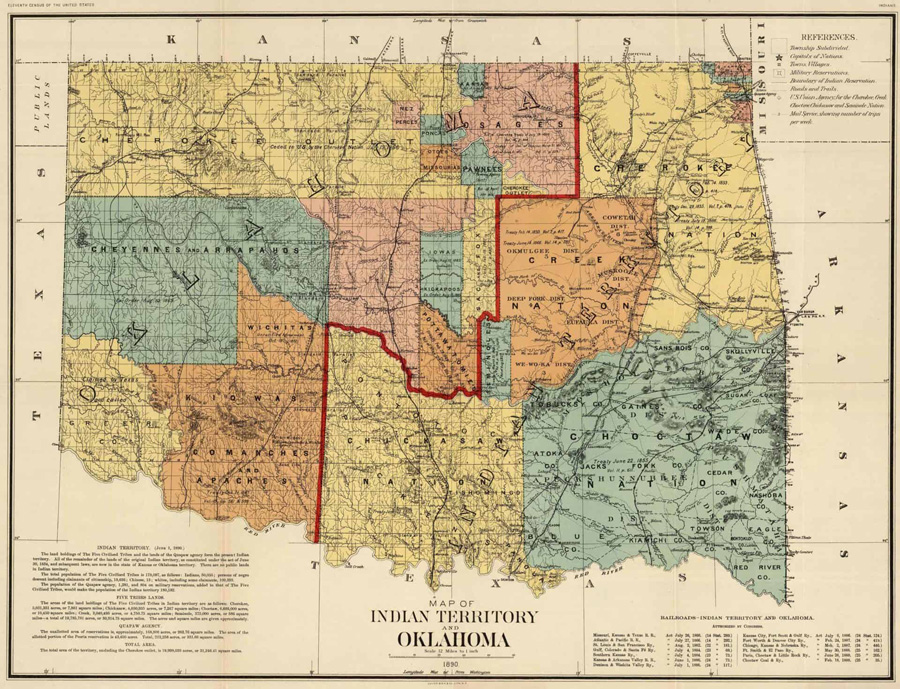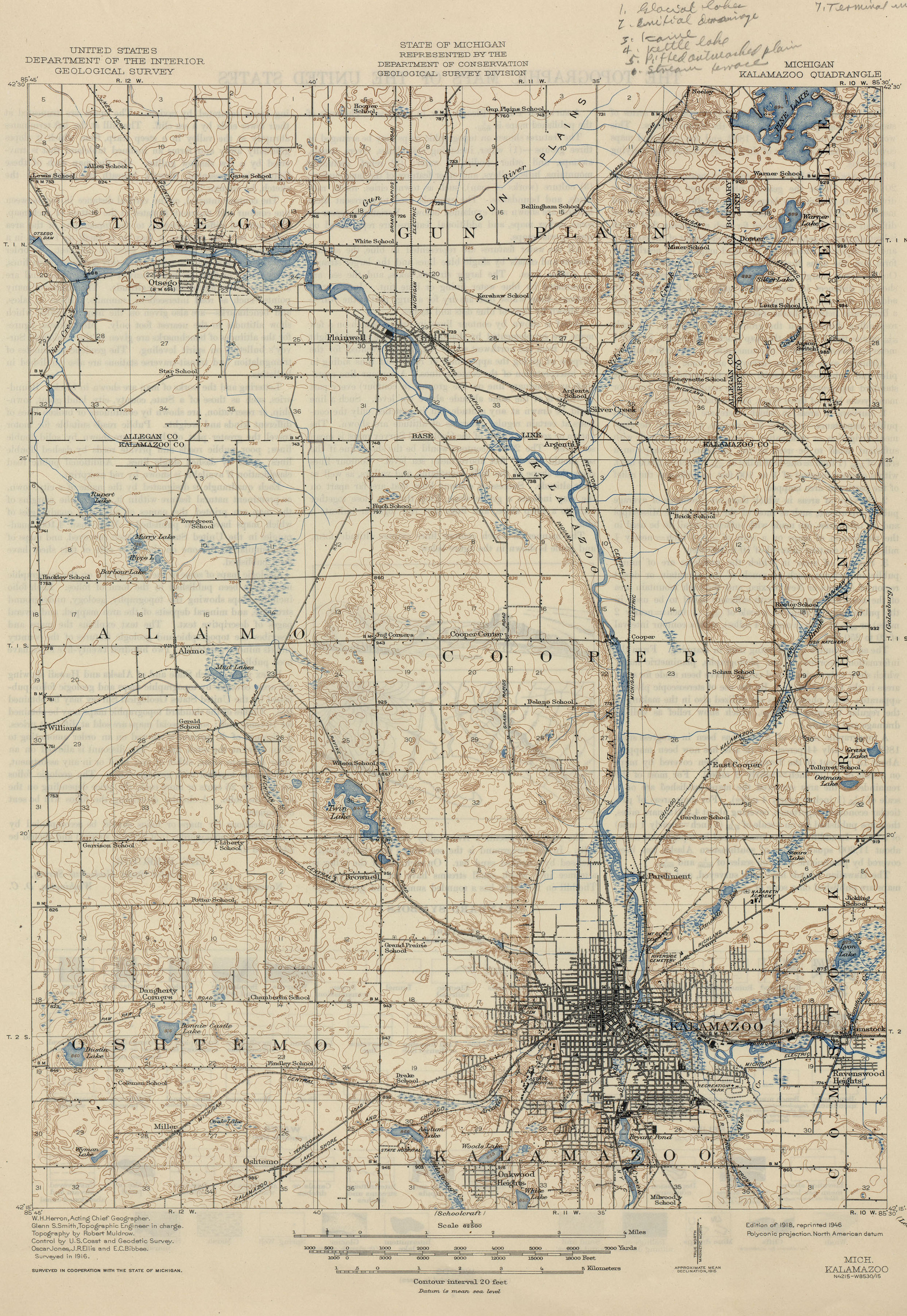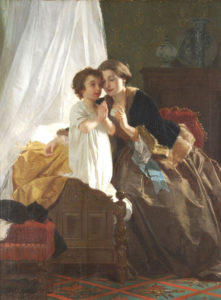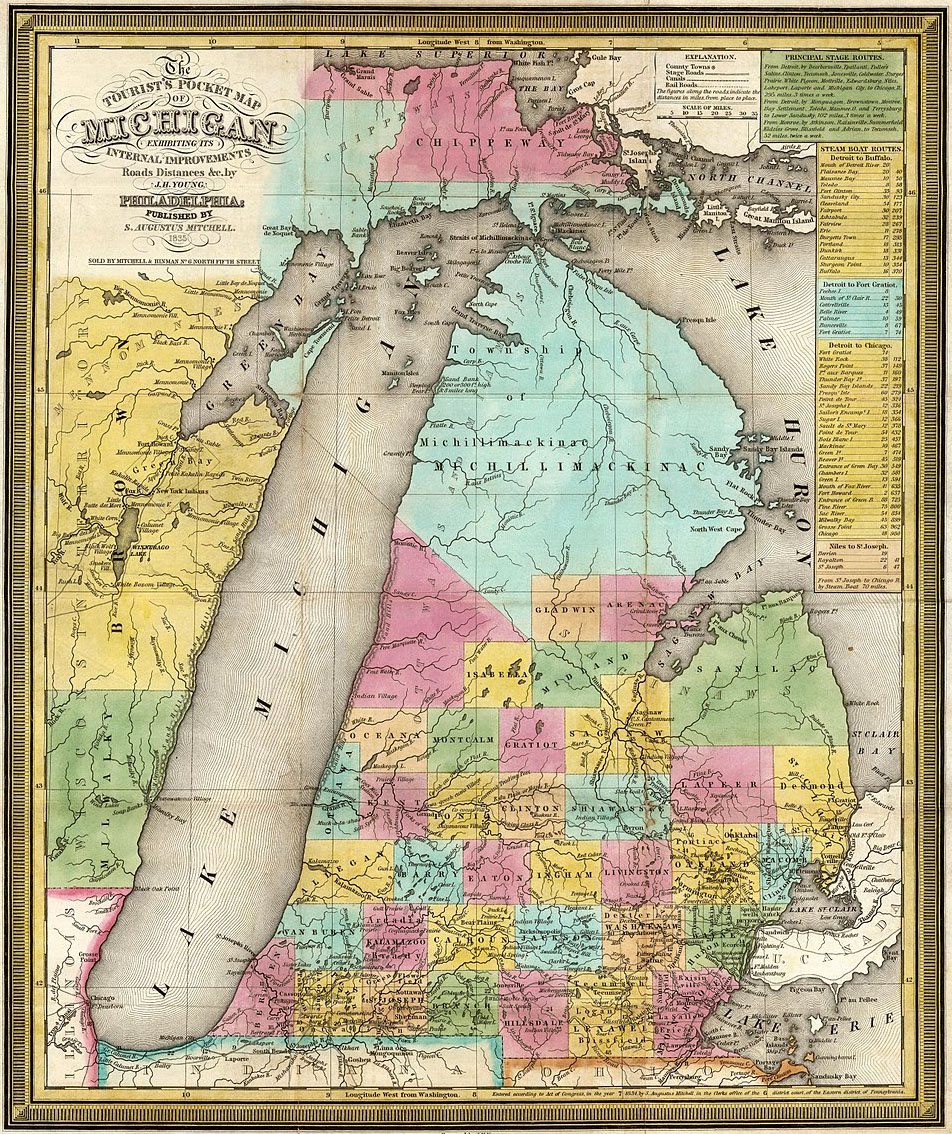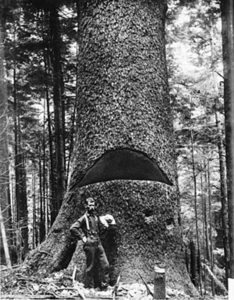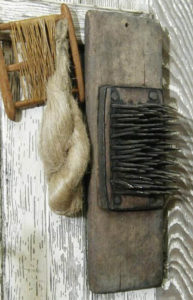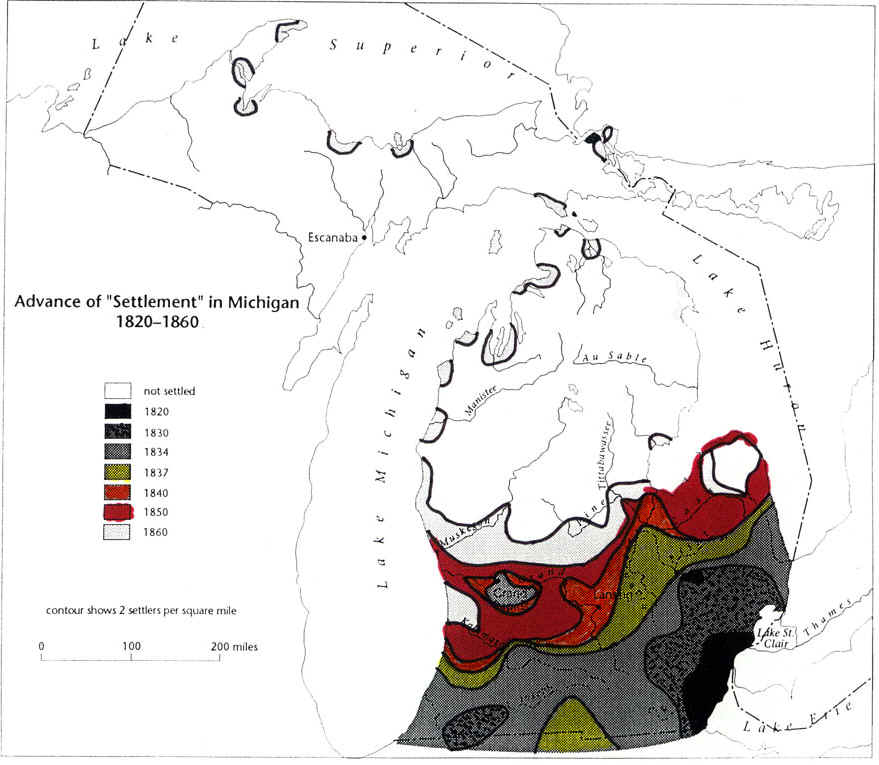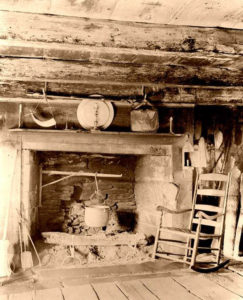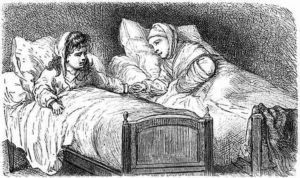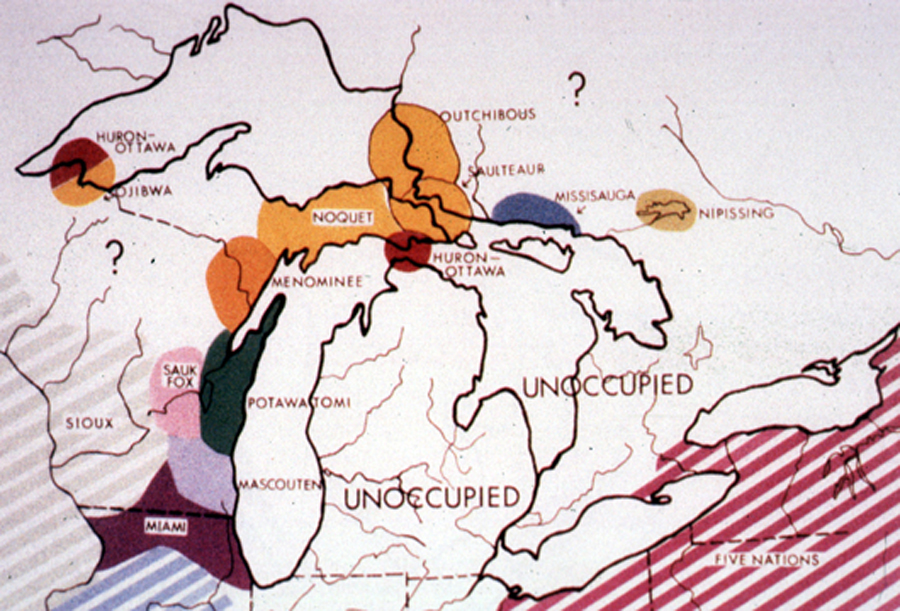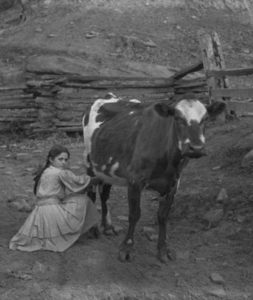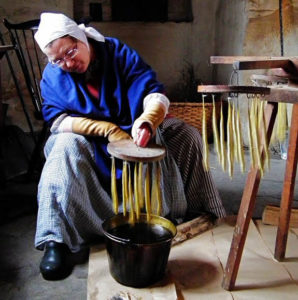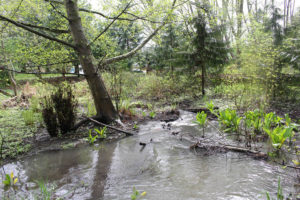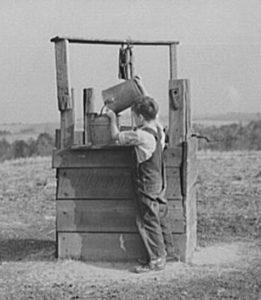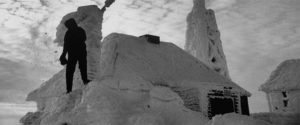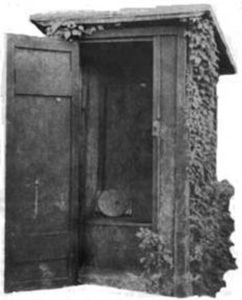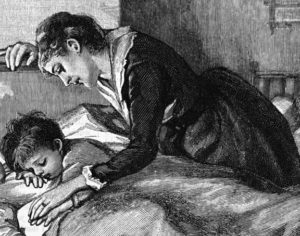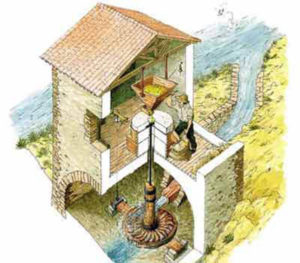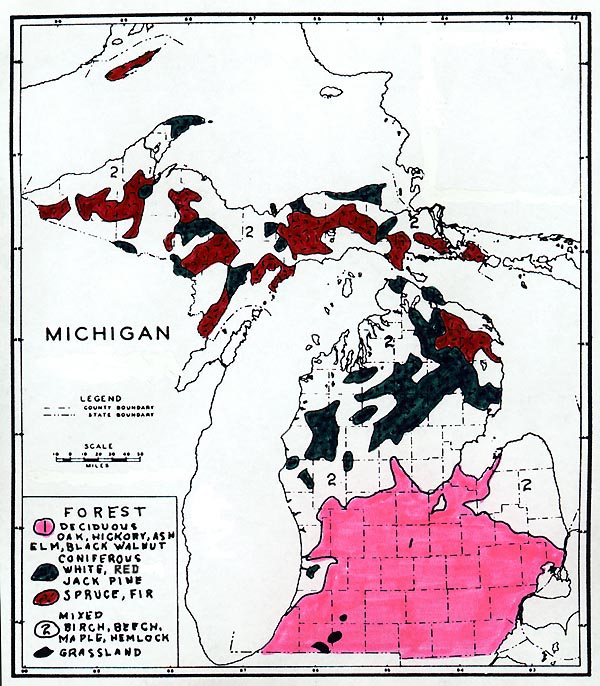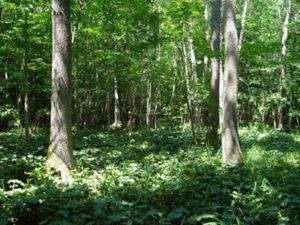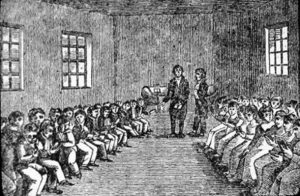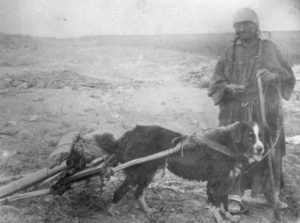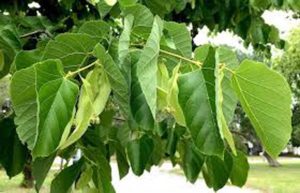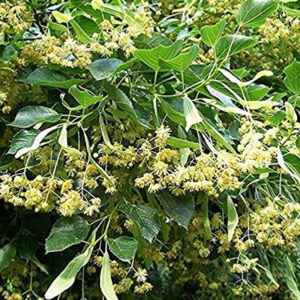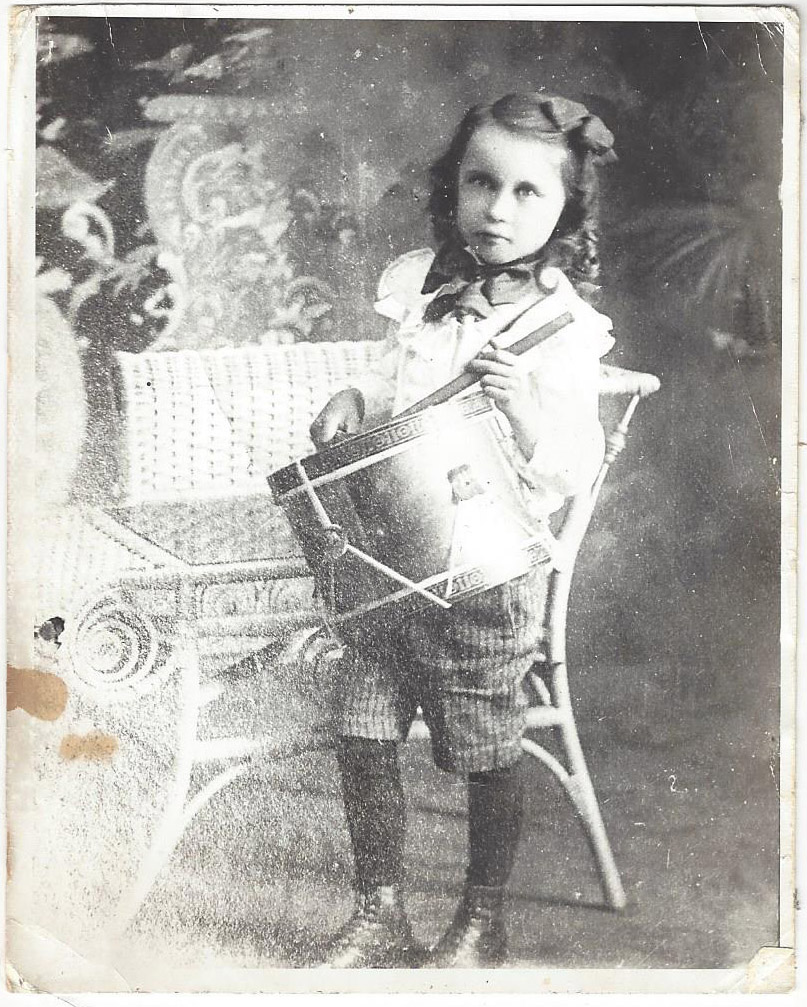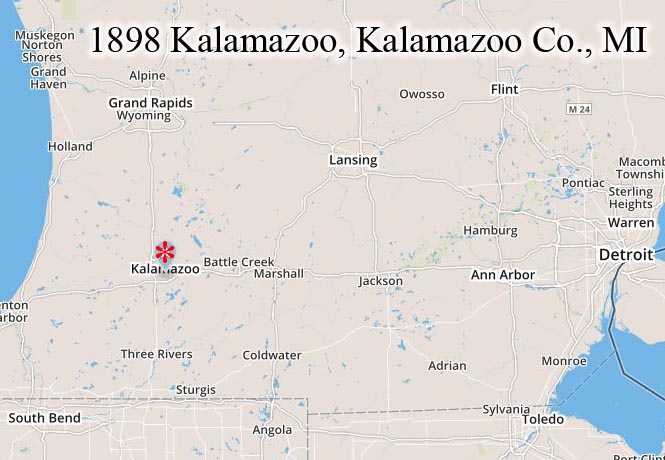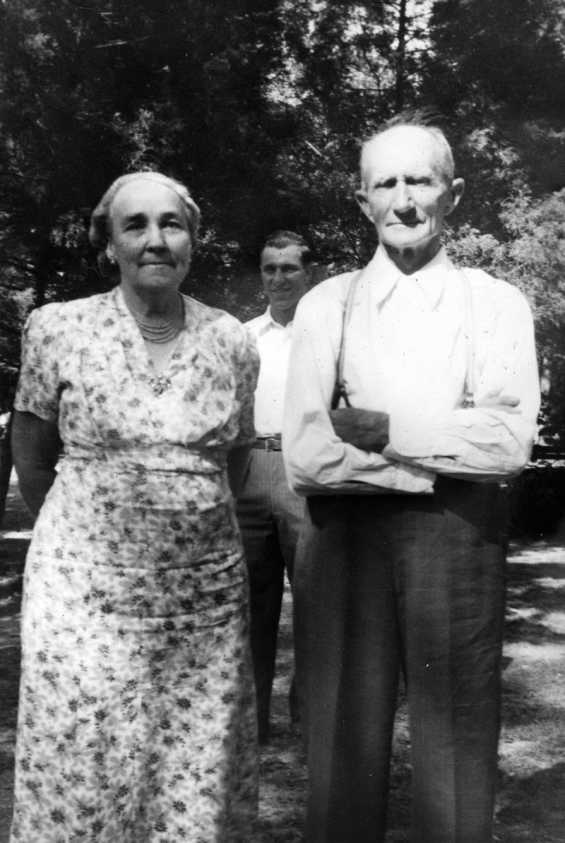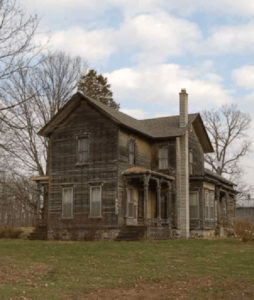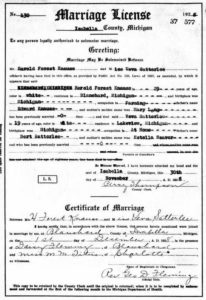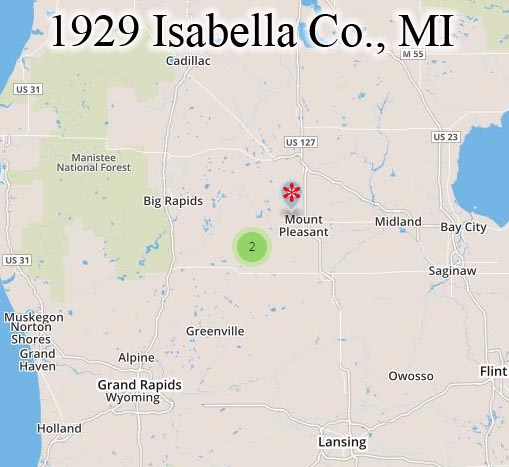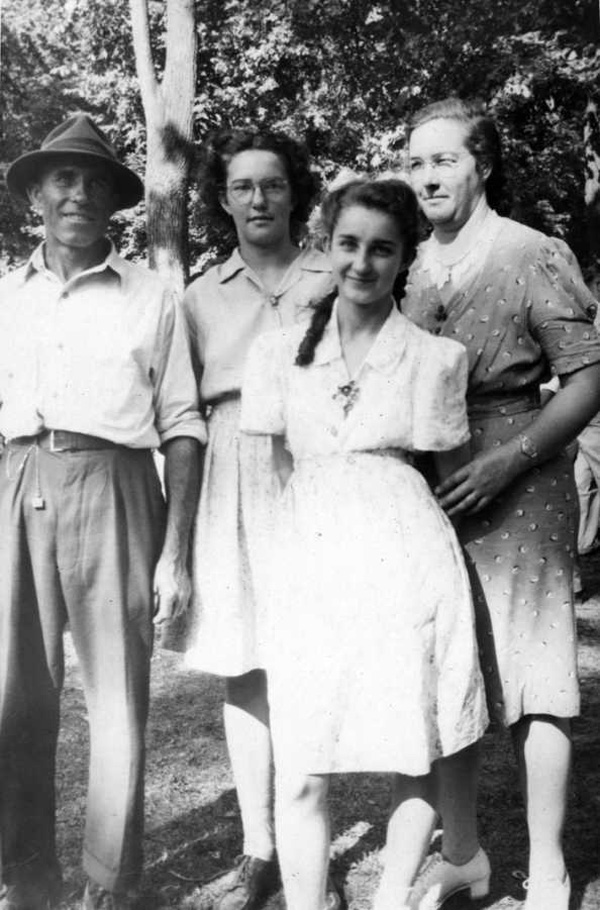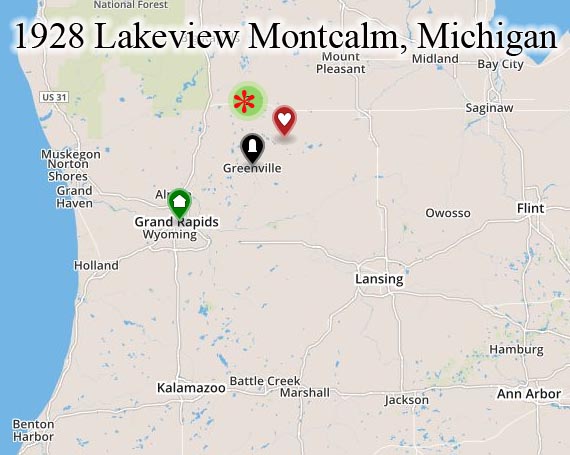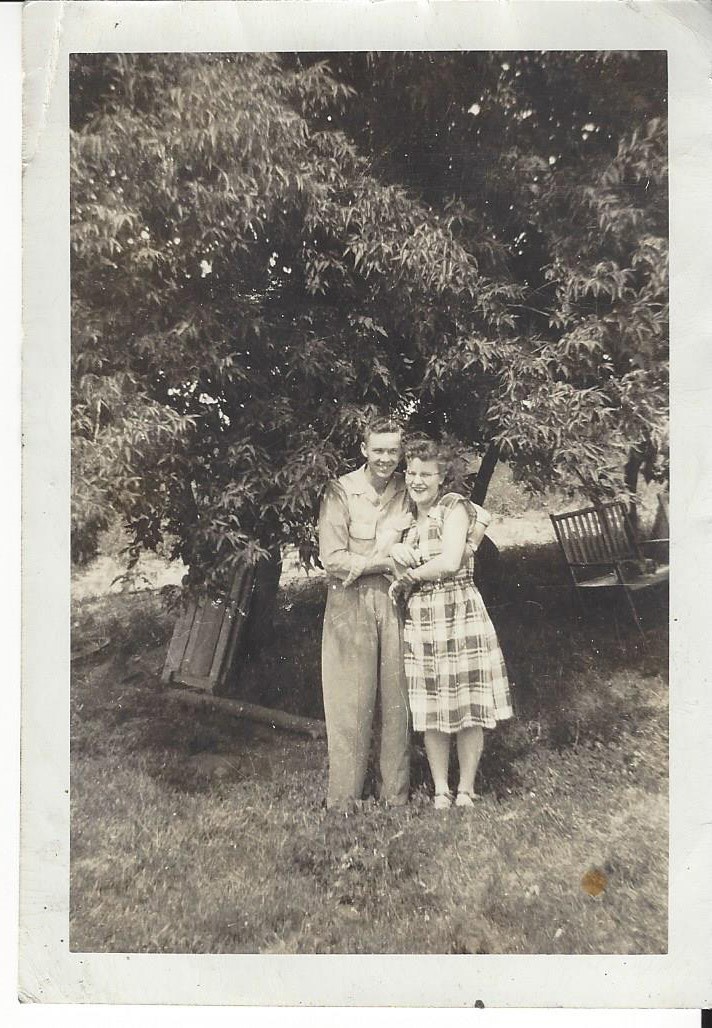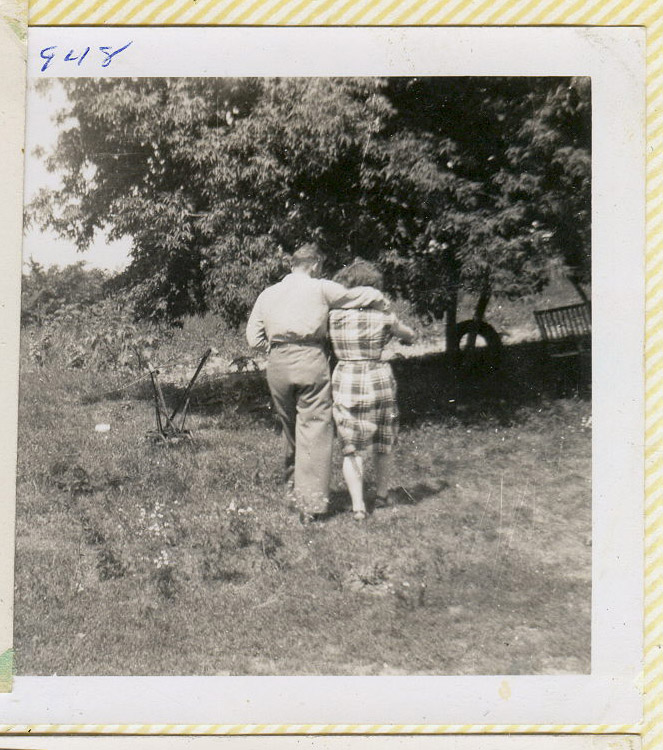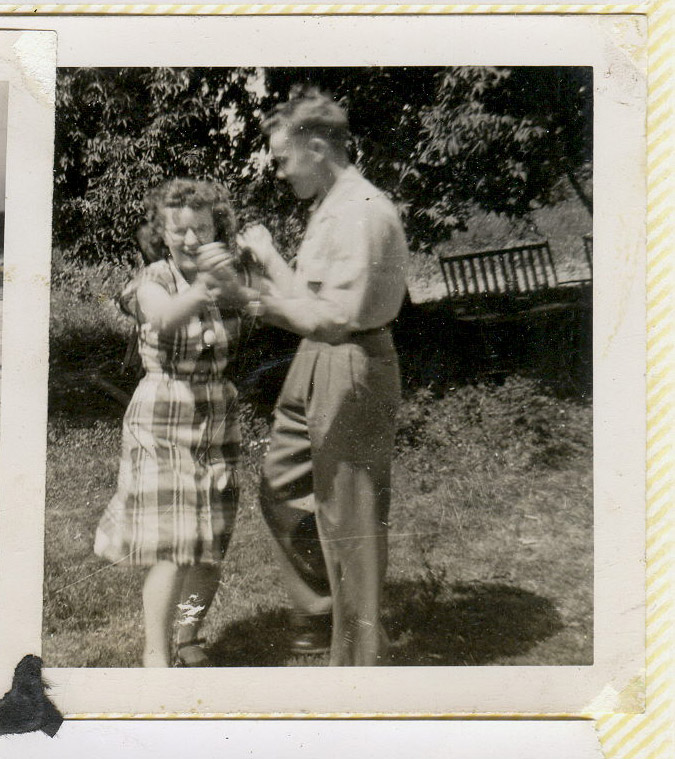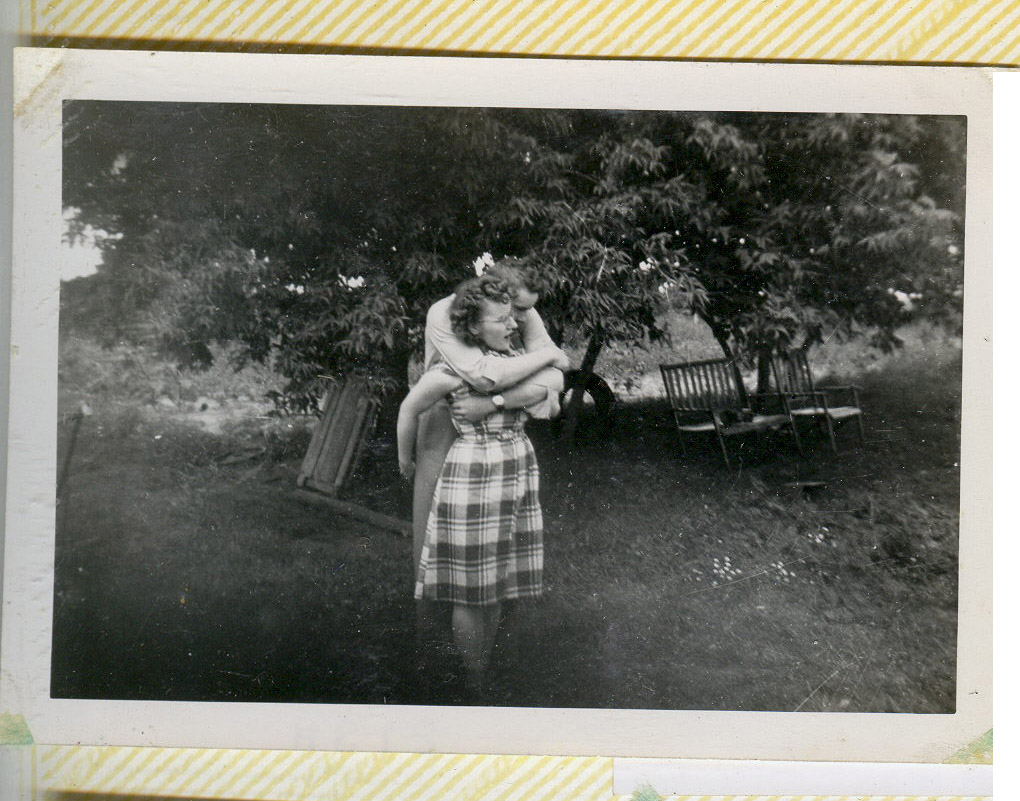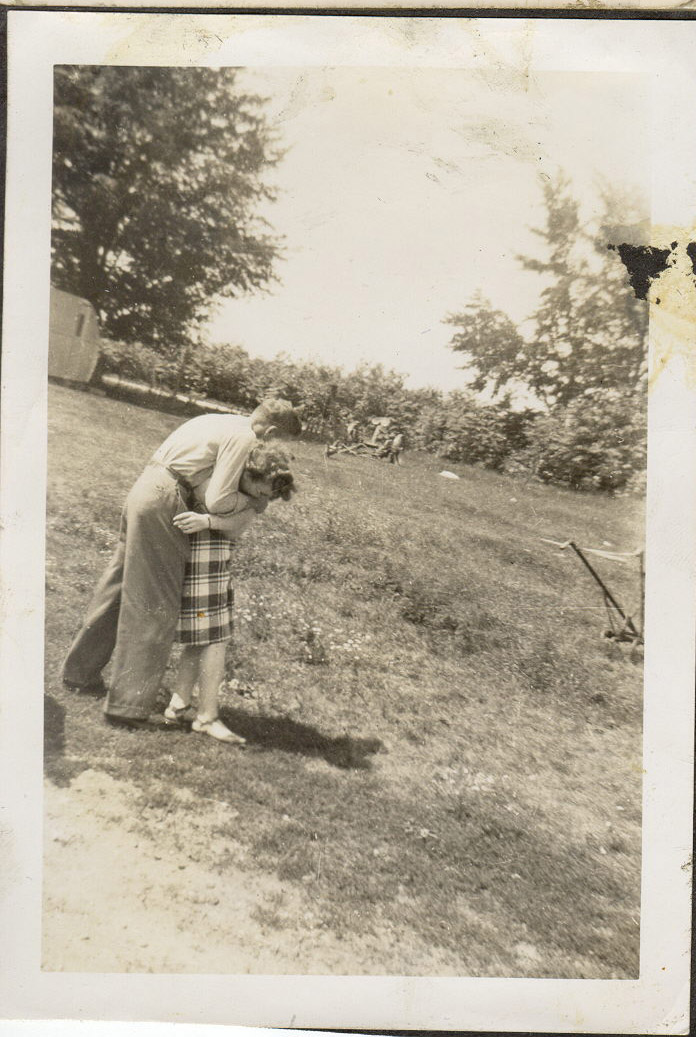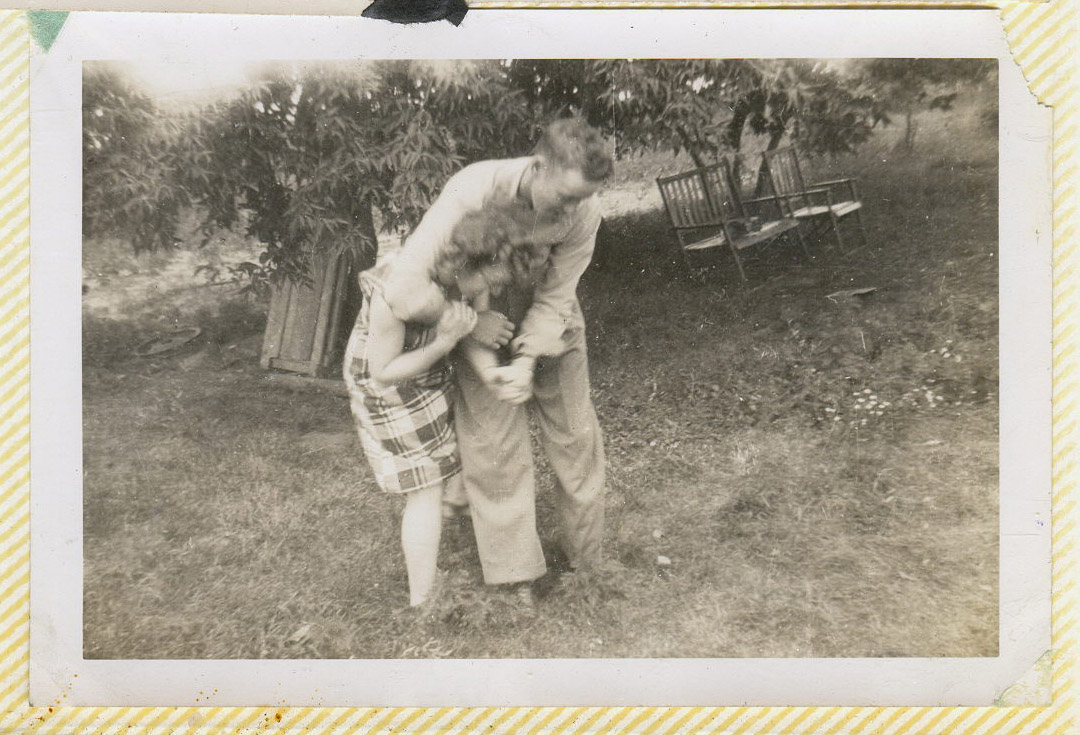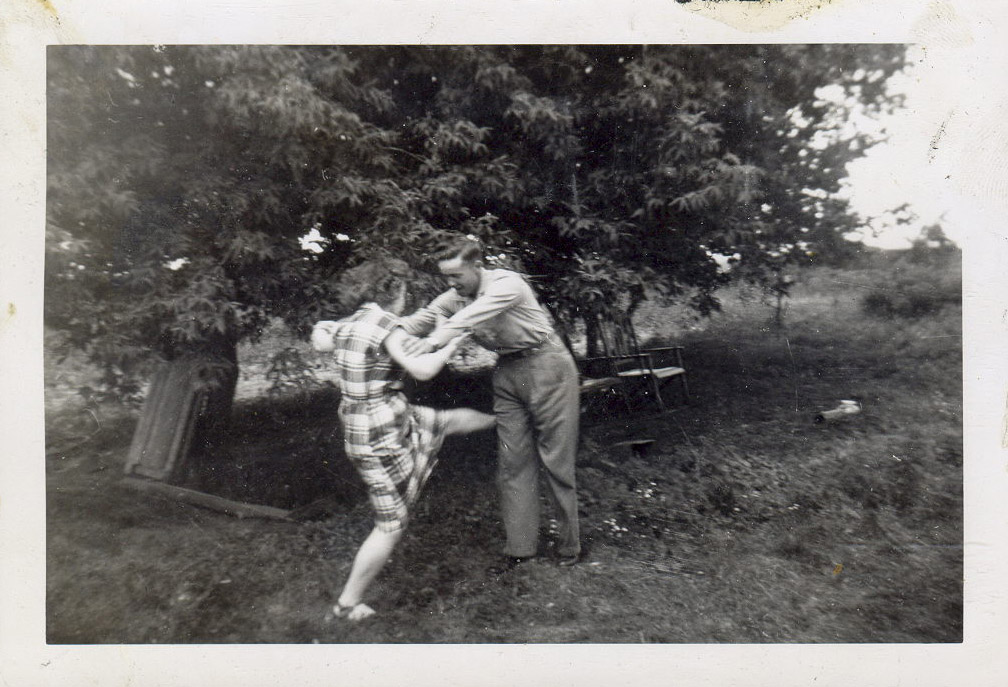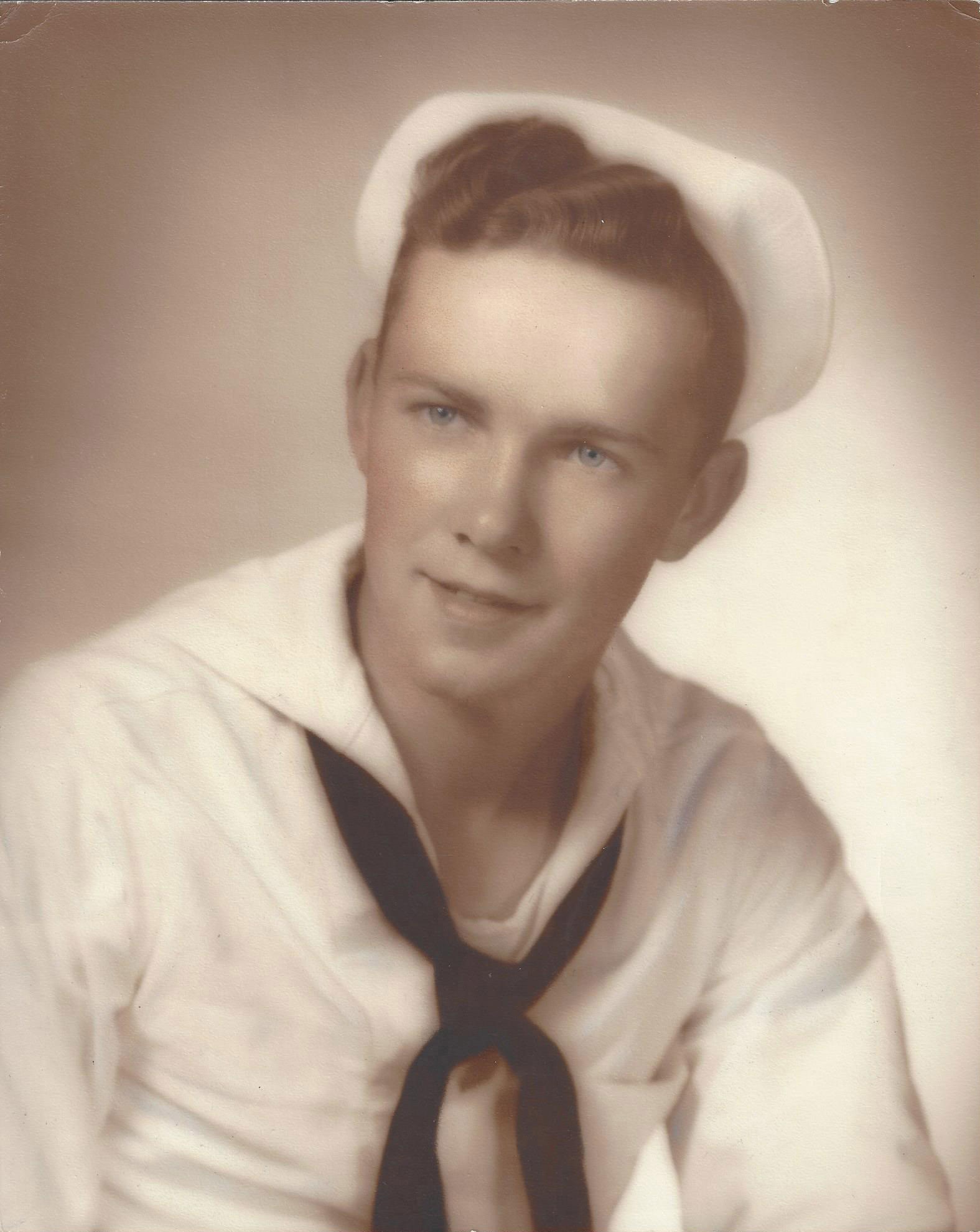farm land from forest
The history of Michigan 11,000 BCE–1608
Michigan territory 1846
David Knauss muster roll
Timeline 1877
Shortly after being mustered out of the army, David went west to Illinois. For a time, he boarded with the Clark family in the Town of Charleston, former home of Abraham Lincoln. Lincoln’s famous Log Cabin was just outside of Charleston. Mrs. Clark was the daughter of Dennis Hanks, whom David knew very well from the war. Dennis had written to him about finding work.
Lincoln’s boyhood home – Charleston Illinois
Timeline 1885 – 1889
David got a job on the railroad running from Illinois and Michigan. While traveling through the states, he saw an opportunity in the open land cleared by the loggers. Good farmland was there all you had to do was remove the tree stumps
The earliest lumbering was done by the French in order to build forts, fur-trading posts, and missions. The British, and later the Americans, used Michigan’s hardwoods to build merchant and warships. Beginning about 1855, white pine became the most desired tree species by the lumber industry of the Great Lakes states. Navigable rivers and extensive pine forests formed the basis of a flourishing pine industry in Michigan.
the history of trees in Michigan
North of an imaginary line from Muskegon to Saginaw, the White, Jack, and Norway pines grew, as well as other conifers (a tree that bears cones and needles). Conifers were the main softwood tree cut by the lumberjacks for construction of homes, barns, and commercial buildings.
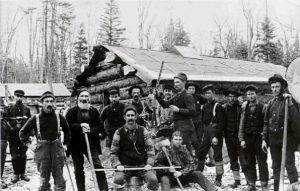
White pine logging camp
Turpentine, resins, and other essential consumer products were made from these trees, which made them vulnerable to the ax and saw. It was the white pine that allowed the heyday of the lumber industry. Many white pines were over 200 years old, two hundred feet in height, and five feet in diameter.
logging white pine in Michigan
Michigan’s pine became necessary as the supply of trees in the northeast was used. By 1880, Michigan was producing as much lumber as the next three states combined. The first area where many mills were built was Saginaw. Six rivers converge to form the Saginaw River, which empties into Saginaw Bay and then Lake Huron.
entrance to Saginaw River
The rivers are the Chippewa, Tittabawassee, Cass, Bad, Shiawassee, and Flint. Streams played a vital part for the loggers because the lumber had to be floated to the mills and then to market.
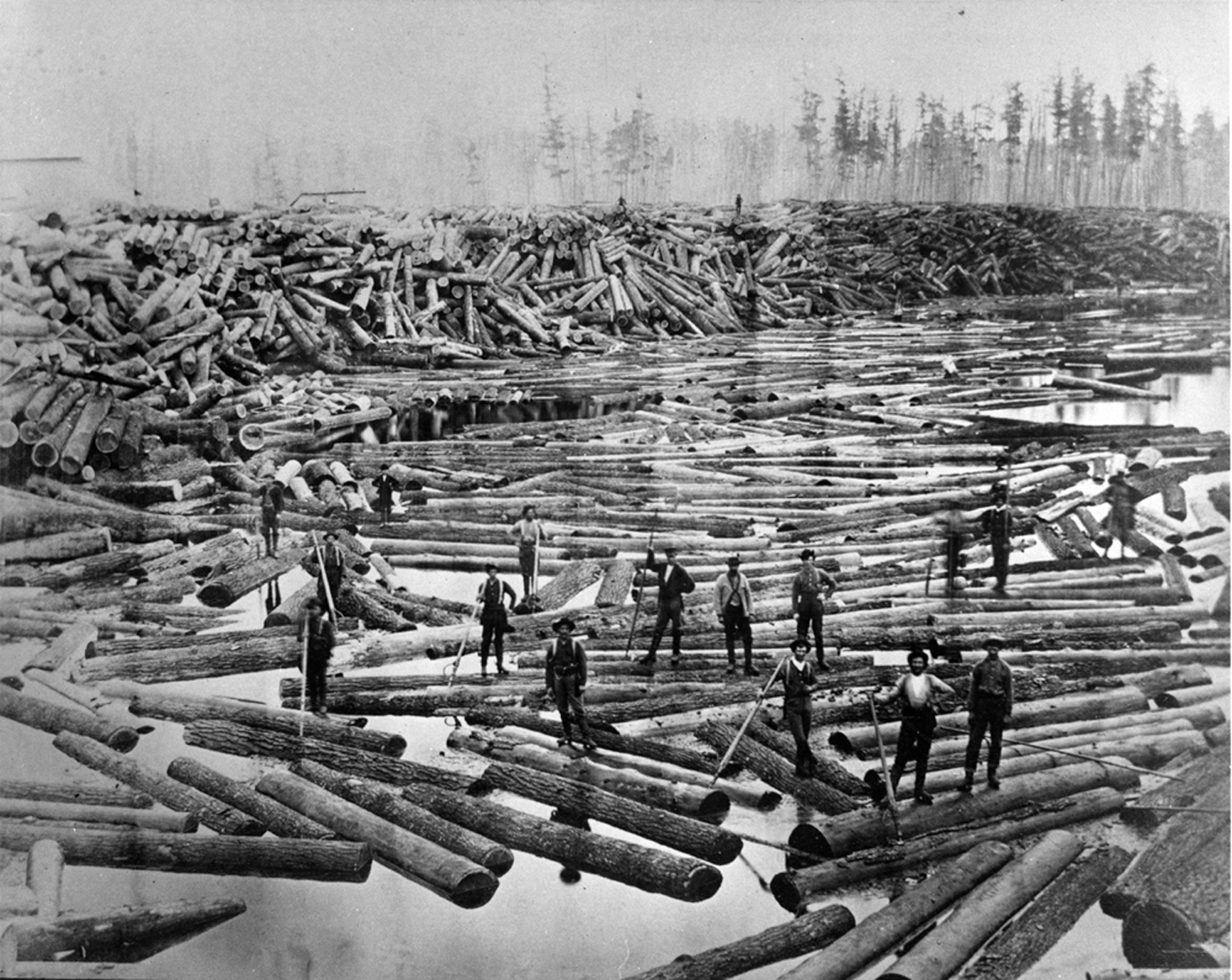 logs floated on rivers to the saw mills
logs floated on rivers to the saw mills
The first group of people to set up lumbering operations were from New England, especially Maine and New York. The forests there were almost entirely cut, so the owners and experienced crews followed the work. Many felt that the vast forests of Michigan would last for many, many years, yet within a 20-year period, 1870 to 1890, most of the trees were cut.
an over cut forest is gone
One year while David Knauss was working on the railroad line that runs from Illinois up thru lower Michigan, he attended a family reunion. Like all the other ones, it was a great time to get up to date on how the rest of the Knauss family was doing.
Toledo Ann Arbor & North Michigan Railways 1828 – 1900
David was not too comfortable socializing, but he did enjoy playing his fiddle with the other musicians. They would all set in a circle some with guitars, fiddles, and flutes playing songs till after dark. David brought his instrument with him, and he let it do the talking for him because he was quite a good fiddler.
railroad workers
But when the music was over, he found himself at a picnic table talking to Amos and Mary Knauss with their son Edward Knauss (1876 to 1952, great-grandfather). They had invited him to sit and have some pie and homemade cheese with them.
Edward Knauss place of birth
Timeline 1878 – 1882
While they were eating, David asked Amos, “so how did you get to Michigan?”
Amos said, “Our family travelled up to Albany by wagon. Then we boarded a flatboat and took the canal to Buffalo. Another boat took us to Detroit. From Detroit, we went by wagon, cutting our way through on an Indian trail from Grand Blanc to Flint.”
horses pulling a flat boat thru the canal
Amos took out of his pocket a small folded piece of paper. He opened it and showed David a crude hand-drawn map, and he used it to explain the trip.
Amos pointed to a spot on the map, “I bought 125 acres of land along the Flint River. There was some good bottom land, some still standing timber and some land with stumps that need clearing.”
1822 Michigan map
David never had much to say he was always a quiet person, and more so now after the war. The members of the family had gotten accustomed to him, not always commenting or being part of a two-way conversation. But when he did speak, he often used German words and phrases.
Amos continued telling David everything he could about the family, “The trip was rough on everybody. We could only bring a few household goods, my grandfather’s clock, and his wonderful bible full of the Knauss family’s history. Grandfather cherished it highly because of the many notations about the family’s history that had been written down by the generations before him. He was not only religiously inclined, but he was quite literary.”
pioneers on the move
David looked at the map that was still in Amos’s hand, and he asked, “are you still living here” pointing to the spot on the map.
Amos brought him up-to-date with his family’s new home, “In 1876, after our son Edward was born, we sold the farm along the Flint River. We headed west to the old abandoned Indian Fields on the trail that runs along the Kalamazoo River.”
Amos used his home-made map again to show David a different spot where his family had moved to. “It was very hard on Mary to make a move so soon after childbirth.”
Michigan Railroad Map 1876
The conversation sparked Mary’s interest, and she spoke up, “When we first got there, the only shelter we had was a tent we made from the wagon cover.”
She looked directly at Amos and gave him a smirky grin, “we have seen what happens when the men in the Knauss family get pioneer fever, they move.”
a covered wagon
Amos had no defence, and he did not try to cover what happens to the family when he gets pioneer fever, so he agreed, “yes, honey, your right.” To avoid talking anymore about his family moving again, he asked David, “What are your plans for the future? Are you going back to Pennsylvania?”
David thought for a moment and said, “I have some friends from the war that moved west to Kansas now that it is a free state. Thinking about going west and get me some of that free Indian land, the government is homesteading to farmers. I’m a farmer, not a railroad man, and I need to get my hands back in the dirt.”
Indian land sale – treaties
Amos spoke again, “where we live now, some of our neighbors are Indians. They helped us get in our first year’s crops, and our yield was quite bountiful, which we shared with them.”
Amos went on to say, “Edward goes to school and plays with their children. He is even learning their language, and he is teaching it to Mary and me.”
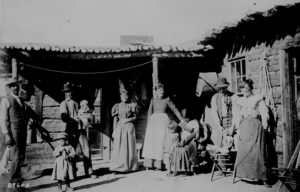
a family group poses with dog, Indian, and young children
Mary spoke up, “We have found them to be very hospital and trustworthy people. Sadly, the Indians contracted smallpox, and most of them died. They never had any white man’s contagious diseases before, and it killed them off rapidly.”
David did not know how to respond because he had not yet had any personal contact or relationship with the Native Americans. He only knew what he had heard about them, and it was not good.
Michigan Pottawatomie Indians Indian family
As they talk, they all knew they had seen better times, but each one was hopeful in a better day to come. They departed that day from the family reunion. Amos, Mary, and son Edward went back to their farm along the Kalamazoo River, and Dave headed west as far as the rails could take him. He settled in Stillwater, Oklahoma. David Knauss died in 1920 at the age of 77, and he was buried in Lyons, Kansas.
David Knauss – Indian Territory and Oklahoma 1890
Amos and Mary Knauss returned to their home along the Kalamazoo River. Edward was their only child, and they spoiled him. Mary was a great storyteller, and Edward love to hear her talk about his family and the people that came before them. Mary told stories mostly about her family, the Shingledeckers, and how they got to Michigan. When Mary was young, her grandmother was the storyteller in the family, and Mary would repeat these stories to Edward.
Kalamazoo
Hearing these bedtime stories connected Edward directly to Knauss families from the past. His mother spoke with authority and about her personal experience. Mary’s grandmother had installed in her how important it was to pass on to the next generation the family’s history. She loved to talk to Edward about her grandmother, and he enjoyed listening to her.
Edward had caught a nasty cold that led to pneumonia, an infection that inflames the air sacs in the lungs. He had a fever, the chills, and he coughed up a lot of phlegm. Mary spent most of three nights telling him the stories her grandmother told her long ago.
sick child
The first night he got sick was the roughest for Edward because he did not sleep once in 24 hours. His coughing kept him awake, and he was just too ill to sleep. Mary, his mother, tried to comfort him the best she could. She gave him a mixture of whiskey and honey to help him with the bad cough. And she wrapped him tight in blankets to keep him warm enough to break the fever with a good sweat. Mary did what her mother always did, she made an onion poultice and hung it around Edward’s neck. Then she gave him some sassafras tea with hot fresh biscuits.
Mary sat on the edge of Edward’s bed and held her son’s head in her lap. As she looked down at his watery eyes, she saw both hers and Amos’s face in his. “How much children look like their mothers and fathers,” she thought to herself. She wished there was something else she could do to make her child feel better and be well again. And there was something else she could do, she could have a word of prayer with the boy.
“Edward.” she said, “Edward, let’s say a little prayer together that the Lord will make you feel better, ok?”
Edward did not answer, but he did nod his head in approval.
Mary started by saying, “Our precious heavenly Father, we know you are the creator of all things. We know you love us because you sent your Son to save our son and us from sin. We know this because of the good news written in the Gospels. We know that all our troubles can be put into a basket at your feet, and you will take care of us. We know you are the great physician and healer. We ask you now heal Edward. Ease his discomfort. Encourage him through this time. Bless him and make him well again. In Jesus’s name, we pray, Amen.”
Jesus the great physician
When Mary opened her eyes, she could see that Edward’s hands were folded and he was praying his own prayer, he said, “and God bless mama too, Amen.”
The young man could hardly say anything, but he did say, “I love you, mama,” and closed his eyes, still resting his head on his mother’s lap. With his eyes still closed, he asked, “please tell me the story about when grandma first came to Michigan again.”
a mother and child praying
This tale had been told many times before. Once when Mary’s grandma told it to Mary’s mother, once when Mary’s mother said it to her, and more than once, Mary had told this story to Edward.
grandma’s stories
Mary remembered the stories from her childhood very well, and she was able to give a detailed account of each incident in her grandmother’s experiences. She told Edward about her conversations with her grandma, and he pretended to be right there with them.
One day when Mary was spending time with her 81-year-old grandma, Mary asked her, “what was it like when you first came to Michigan?”
Her grandma thought for a moment, then smiled and said this, “My family first came to Michigan on a soldier’s pension promise. The U.S. government promised free land in Michigan to any veteran of the Revolutionary War, although they did not expect many to claim it, my father did. He grew into manhood while in the war at the age of 18 as a captain of a rifle company. He served at the place that was his home until pioneer fever sprung up in him. After the war, he had some money saved, and he bought a small farm100 miles away in west Pennsylvania.”
pioneer family
Grandma told Mary she was only about 3 years old when her family left their home and moved to Michigan. “My father, I called him Papa, was took-down with the pioneer fever again and in 1841 he got an itching to move to someplace new. So, he sold his farm and loaded all he possessed into his lumber wagon along with a few chickens, two piglets, one wife, and five children. With a good team of horses pulling the wagon and two cows in tow, he headed towards the frontier of Michigan.”
Michigan 1835
Grandma went on to say, “I don’t remember how old I was at the time, but I had not started school lessons yet so, I was younger than 5 years old.” When she paused, you could see a spark of joy in her eyes as the older lady remembered, the younger one.
Then she chuckled, “I road in the wagon setting in my chair on top of everything else. When a wheel fell off while going over a big dead log, the chair was tossed off the load with me still in it. Everything in the wagon spilled out all over me.”
She told how her father was more scared than she was, and it was the first and only time she saw him cry tears of fear. From then on, her father kept her by his side on the wagon seat during the day, and she was put to sleep at his feet each night.
pioneer wagon
Like many other pioneer families, they were looking to clear good farmland of the stumps left by the lumbermen that had cut down the trees a few years before. Michigan was a dense forest of Basswood, White Pine, and Black Walnut trees, sometimes four feet in diameter. Using only a hand axe, the trees that still stood were cut and burned to clear the land for the plow.
plowing with Oxen
Grandma explained that “burning up these great trees would sometimes take two weeks or longer if the logs were green wood.”
She went on to say that her father oversaw the Ashery, and he collected the ashes of the trees after they were burned. The ashes were used to make saleratus, and it was sold as a replacement for baking powder for 10 to 12 cents/bushel. The ashes contained a natural form of sodium bicarbonate that made baked goods like biscuits rise.
You could see the sadness in grandma’s eyes as she said, “these great monarchs of the forest were felled to make a place to sow the wheat, flax, and potatoes for the family’s survival. How we would like to see, them growing still today.”
She went on telling how her father cleared a few acres, and the soil was made tillable for farming. It gave the family a small living, but they still relied on the forest all around them for fish and game. Grandma explained, “Papa used the logs from the trees he cut down to build a small cabin in the middle of the cleared land, and he made a lean-to for the animals.”
great monarchs of the forest
Grandma described what was done next, “After the ashes were collected and the ground laid bare, we all helped breaking up the moist soil with a rake, shovels or whatever we could find so it could be planted.” Food was not the only thing that was planted by the early farmers, Flax was started from seed, and it was used in making cloth and other household articles.
a Flax hackle
There was the same respectful tone in her voice each time grandma mentioned something to do with her father. “Papa cut down each tree, split each rail, and made every board used to make our cabin all by himself.”
Pioneer families lived far apart from each other, and sometimes the closest neighbor could be over 20 miles away. These were families living alone and totally dependent on their own self-effort to survive in the yet untamed forests. These woodlands provided good hunting for squirrels, rabbits, deer, and moose for fresh meat. However, there was still bear, cougar, coyotes, and wolves living in the trees beyond the field grandma’s father had cleared.
settlement in Michigan
Grandma described her home, “papa built a fireplace in our cabin made from stones he had collected along the water’s edge. I used to help him pick out the ones he should use, and I helped carry them to the cabin. When the fireplace was done, and for a long time after, I could look at it and remember each stone and the fun I had that day playing in the water with papa.”
cabin fireplace
Grandma told about one day when “Papa traded a young pig for an iron cookstove that had a large flat cooking surface and an oven with a door.”
Grandma went on to say how much they love that stove and the bread and cakes that were baked in the oven. “From then on, a kettle set on the stove and mama always had hot water for tea or coffee, and there was always warm water to wash up with.”
Grandma said that her “mama sometimes kept a small kettle of potatoes in hot water for us kids to eat during the day.”
Grandma told a sad story about when she was too young to help herself, she tried anyway, and the kettle of potatoes overturned and spilled hot water all over her. She was severely scalded with the boiling water, and as an adult today, she still had the scars on her arms to prove it.
Grandma told about her mother, “I still can see my mother on her knees scrubbing the puncheon floor until it was white.” Many cabins had puncheons for the floor, which are split logs flattened on one side only. These ruff boards had many slivers that had to be scraped smooth before bare feet could walk on it.
“There were two beds put in one end of the cabin,” grandma said, “and my trundle bed was underneath.”
She spoke about how cold it got at night sleeping so close to the floor and how she was glad the dogs would lay real tight next to her. “I love the trundle bed song for it brings back good old memories which were full of privations yet dear to my heart,” and then grandma began to sing a song from her youth,
“As I rummage through the attic
Listening to the falling rain
As it pattered on the shingles
And against the windowpane
Peeping over chests and boxes
That with dust were thickly spread
Saw I in the furthest corner
What was once my trundle bed.”
a child’s trundle bed
Grandma spoke again about her mother, “mama was a weaver of cloth, and she was a fine seamstress. She hand-made all of our clothes and stitched them up when they wore out.” Grandma recalled that there was little room in the cabin because of her mother’s spinning wheel, quill wheel, and a small flax wheel.
spinning wheel
Flax was a blue-flowered herbaceous plant that was cultivated for its seeds that were made into linseed oil, and textile fibres could be made from the stalks. Flax was almost always the first crop to be planted because of its many household uses. Wool was preferred over Flax for articles of clothing for young and old because it was warm and long-lasting. When sheep were not available for wool Flax could be cultivated, spun, and woven into cloth.
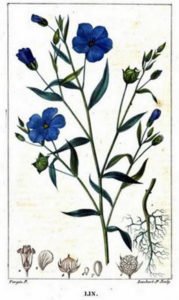
the Flax plant
Grandma shared a fond memory, “One-year mama made me a brand-new wool dress. She said that my last year’s dress which had been spun and woven in the home would be good enough for school. The new dress was decorated with red cloth at the bottom, and it just swished across the floor as I walked. Mama had stitched a small piece of lace at the neck and at the cuff of each sleeve.”
Grandma said that later she saw that mama had cut the lace off one of her best dresses to make the new one for her. Grandma said, “I was so excited to go to Church dressed so fine.”
“When papa could get wool, mama would make us nice warm stockings and scarfs. One year she made papa a wool coat, and he hardly ever took it off during the winter months,” Grandma chuckled again.
Grandma’s memory was good, and she recalled, “My father and mother each had their own chair they had brought with them from back east in the lumber wagon. These were larger chairs then mine made for adults, and they were most prized by mama and papa.”
Grandma went on to say, “at the end of the day, having a comfortable place to sit as the sun went down was very pleasurable, especially in your own chair.”
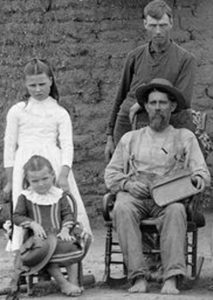
pioneer chairs
“Most of the time, children sat on stools or benches made of rough sawed boards,” Grandma said, “one day papa came back from trading with the backs and frames of six chairs. He made splints of ash wood for the seats.”
The far-off look in Grandma’s eyes gave away that she was deep in thought. Then she said, “we were a proud family when we got new chairs, even though they were not overstuffed, we were proud of those new chairs.”
Edward’s coughing interrupted his mother’s story, and Mary stopped to adjust his blankets and get him some more sassafras tea. He had not eaten any of the first biscuit, so she did not get him another.
She told him, “Son, you must try to eat something even if you don’t feel like it, you must keep up your strength.”
Edward moaned, “but I’m not hungry, …cough…cough…” he set up a little and said to his mother, “you did not finish the story yet.”
Mary told Edward that grandma shared her memories of what it was like to be a child back then when her family first came to Michigan. She said, “In my younger days, everyone in the family had to work together to scrape up a living, even the youngest.”
Grandma continued, “There were no fences around the cabin, so the cows were allowed to wander in the woods and search for food. Every night one of us kids was sent into the woods to find the cows and herd them back to the lean-to for milking time. It was hard to find anything in the thick undergrowth, even something as large as a milk cow.”
bring home the cows
Then Grandma told a little secret, “The leader of the heard was named May Bell because papa had tied a bell around her neck, and this made it easier to find the cows in the brush.” Grandma spoke really soft when she went on to say, “It was terrifying! You did not know where you would find them or how long you would be out there.
Indians of the Great Lakes
While searching for the cows, I saw many traces of torn down wigwams and paths made by the Indians as they roamed the forest or went to trade their game and furs at the trading post.
Indian trading furs for white man goods
At night you could hear the pack of coyote’s howl, but if they saw you, they usually would run the other way. But when wolves were known to be in the area because they were heard howling in the night, papa would take his rifle and both dogs to bring in the livestock. Papa’s rifle was always kept above the cabin door within an easy reach. From an early age, papa taught us how to use and respect a gun. Everybody in the family could shoot very well, boys, girls, and mama.”
a pack of wolves
Grandma went on to tell about when “one-night wolves were known to be in our neck of the woods, and papa heard the cows bellow like they were being threatened. We had already lost one young steer, and papa was not about to lose another to wild animals. He and the dogs took off, and very shortly, we heard shots from not far away. We could hear the dogs barking and papa yelling orders at them, but we could not understand what he was saying. We heard first one shot, then another, and the dogs kept on barking. Then we heard a single shot from his rifle, and then all was still. And we waited. And we waited.”
Grandma waited for a moment before continuing, “When we finally saw papa emerge from the woods, the dogs leading the way. He went straight to one of the horses and hitched up a tow rope. We ran over to find out what had happened. He told us that a big buck had tried to get a drink from the water where the cows drink each day. After so much time of the cows drinking in the same spot, their hoofs had cut up the bank so much it was a mud bog. The deer was unaware of the mud and had stepped right in. When the deer tried to jump out, it became stuck up to his neck in deeper mud and could not free himself. The deer’s bleeding cries for help were heard by a grey wolf who was trying to reach the deer when papa arrived in this scene.”
Grandma said, “The wolf could not get to papa because of the mud bog between them, so it was an easy shot when papa put the wolf down, and he stopped him from suffering, with the second shot. The third shot we heard was when he killed the buck. Papa used the horse to drag the deer back to the cabin, and most of that night, we spent cutting up, salting, and smoking the venison. We also hung up strips of meat to dry on a rope between the cabin and the lean-to. This made delicious jerky for carrying with you when you travel. Papa mounted the 10-point deer antlers above the cabin door, then he traded the wolf pelt for $5 and some supplies that we needed from the trading post. In those days, butter was 10 cents a pound, and eggs were 25 cents for three dozen.”
Cadillac trading post 1800s – French fur traders map
Grandma said that she remembered that day because “me and my brothers and sisters all got candy the day we went to the trading post. It was a hard choice between licorice sticks or rock candy when you like them both. All in all, this time, the forest had paid off in benefits for the entire family, and we never heard or saw signs of a wolf around our cabin again.”

time for some candy
Grandma talked about her pet, she said, “Papa raised ducks to trade at the post, and when I was a young girl, I had one as a pet. One day I found it lying by the water, and when I went to pick it up, I could tell it was dead. Shock and anger took over me. Being a child without any logical reasoning, I looked along the shore, and the first thing I saw was a big bullfrog. When the rest of the family missed me and came looking for me, mama was the one who found me. There were over a dozen dead bullfrogs tossed onshore. She cleaned me off the best she could with her apron, and she fought against her uncontrollable laughter as we walked back to the cabin. At supper time that night, the entire family thanked me for the great frog leg dinner.”
Grandma said once, “when I got older, maybe about 5 or 6 years old, it was my twice-a-day chore to milk the cows. There were just a few to milk, it did not take long, and I loved the fresh milk. Sometimes they would fill a ten-quart pail of milk that I had to carry to the cabin. One night when I was very small, a neighbor came to visit just as I got done milking. As I was carrying the pale back to the cabin, he told me, “Sis, I would think that cow would not know you from a bone-picker.” It was seen to, that each of us did our part of the work, no kicking on child labor then.”
Milking the cows
There were other animals besides wolves that bothered cows, and the porcupine was one of the worse. They lived in the lower brush close to the ground that was easy for the cows to reach and eat. The cows could push their fasces directly in the line of fire of the quills defending the porcupine. Unless the quills could be removed rather easily without hurting the cow, it could starve, or it may have to be killed.
Grandma told a story about, “When I was a young girl, about 12 years old papa allowed me to bottle feed a young calf. When it was born, the mother cow died, and pap had me blow my breath into its nose. From then on, the calf thought I was his mother.”
Grandma talked about her calf, “He was my pet, and we even let him sleep in the cabin with the family during its first winter. The calf was always the last one to sleep at night, and the first one out in the morning. Because his milk came from me, the calf followed me when I was in the yard. Even when it was a fully-grown steer if it saw me, it would come to me. When he walked breaking his way thru the brush foraging for food, he made quite a rustle, so papa called him ‘Russell.’”
cow in the cabin
Grandma went on telling her story, “One day, Russell had the bad misfortune to be on the south side of a porcupine heading north and took a direct hit in the face.”
Quills were stuck in a pathetic pattern around the wounded animal’s mouth when the family found him at the lean-to. “When he saw me, he came right to me next to the cabin. Papa came over and handed me his pliers and told me to see what I could do for Russell. Carefully as I could, I removed the first quill, and as I did, Russell flinched the only time. From then until I was done removing the last quill, the cow stood as still as a statue. The family felt sad later when papa sold Russell to a neighbor for a breading steer.”
Russell the steer
Edward was fighting sleep while listening to Mary tell her grandmother’s stories. He asked, “what did your grandma do when she was a kid?”
Mary told him what her grandma had said to her, “During the warmer months of the summer, it was the job of the children to gather wild grass from the dried-up swampland and store it for winter feed for the animals. We had so much fun running through the tall grass in the huckleberry swamps. The huckleberry bushes were twice as tall as papa and as big as our cabin. They were all full of big dark blue huckleberries ready for picking. The stain around our mouths and our blue tongues always gave us away on what we were doing while we were supposed to be working. There were other fruits for the picking in the forest like wild plums, wild strawberries, and wild grapes.”
Grandma went on to say, “In the early spring months large trees would be cut down so the cows could browse on the tender branches for feed. This had to last them until the grasses started to grow, and sometimes the cows got a little thin in the flesh waiting. Papa burned all the trees he cut to clear more land for farming. Sometimes he had fires, as big as our cabin going all day and night to get rid of fallen trees.”
tree falling with axes – Michigan 1801
Grandma told how they made candles, “We used rendered animal fat to make, by hand, tallow candles which were the only light we had at night other than an open fire. We molded the hot waxy animal fat in our hands around a small piece of cloth used for a wick. Sometimes we dipped wicks in and out of the hot fat that would cool quickly and harden. They were greasy and stinky, but you could see what you were doing in the dark if the wind was not blowing the flame out.”
making tallow candles
Mary told Edward that back in grandma’s days, there was no running water in the house, and grandma said to her that, “We got all our drinking water from a spring that was some distance from the house. I had to carry more buckets than I can count of water sloshing and spilling all over my dress from the spring to the cabin. Although it was a little walk, the water was cold and tasted really good. Even in the hottest part of the summer, the spring was the place you could always count on getting a cold drink. The water flowed fast enough all year that it did not freeze over in the coldest winter months. One early morning just after dawn in the winter, I met a deer at the spring we scared each other, and we both ran away.”
a spring
Grandma said, “In the fifth year of living in that small cabin papa with some help from some of the neighbors dug a well close to the house. After a time, the old bucket we used to draw the water up from the bottom became covered with moss, and it gave the water a funny taste. Sometimes I would still walk down to the spring and get some fresh good tasting drinking water. The water from the well was nice and convenient, but it could not compare with the water from the spring.”
well water
Grandma told me how, when she went to school, “Our schoolhouse was one mile north and one-half a mile east of our cabin. We usually walked that distance twice a day going and coming from school, but if papa had to go somewhere that day, we would get a ride with him in the lumber wagon. I still remembered falling out of it when I was younger, so I always asked to set next to papa on the seat.”
Grandma told another story, “One winter after a massive storm, the snow was piled up as high as the horse’s belly. We had a tough time walking in the deep powdery stuff, but we still tramped through it to school and back. There were no road snowplows back then.
early snow plow
The next day the blowing snow made it white-out conditions outside, and papa had to string a rope from the cabin to the lean-to. He walked along, hanging on to the line so he would not get lost in the blizzard. Even at high noon with the sun shining, you could not see but two feet in front of your face. It was very easy to get lost. The storm lasted four days, and before it was over, a strong nor’ easter wind blew the snow into large drifts that were as high as the roof of the cabin. Papa followed the rope he strung up the day before and dug a tunnel through the snow to reach the animals. When it got colder, all the snow froze, making the tunnel a stable path through the winter weather. It lasted for several weeks, giving us cover from the weather before it started to melt and collapse.”
snow up to the roof
Grandma went on to say, “When the snow was too deep for the lumber wagon papa made a bob-sled out of a big wooden shipping create. He put skis on the bottom of the create and pulled it along with the horses. Sometimes he would hitch up the team and take us all for a ride on the frozen water. When we got back, mama had some hot broth and biscuits waiting for us. These are good memories of my childhood.”
average snow fall
Grandma always had another story to tell, “When the sun went down, we used our home-made candles for light in the cabin. When it was bedtime, Papa would shout, “last call,” and he would escort us kids to the outhouse for the last time before morning. There would be a string of barefoot children dancing in line waiting for their turn. You could hear the crickets and fight off the mosquitos in the summer and watch your breath freeze in the winter. One of us was always saying, “come on, hurry up, the rest of us have to go. Papa always told the boys not to get the seat wet. One of the boy’s chores was to cut up logs and keep the firewood box next to the stove full. One of the girl’s chores was to clean the outhouse with lye, and I hated it when it was my turn.”
the outhouse
Edward had not said a word for a while, and when Mary looked down, she saw he was finally sleeping. After a whole day and night of being awake, she hoped he would get a little rest, and he did.
fast asleep
Morning of the second day came early when Edward started coughing again. Mary gave him some more whiskey and honey, and it seemed to help him some.
When Mary sat down next to him on the bed, Edward asked, “tell me more about what it was like for your grandma living back in pioneer times mama.”
Mary told Edward that her grandma said, “Every few weeks we had to take our wheat and corn to the mill so it could be ground into flour and I was often my father’s companion on these trips.”
water powered flour mill
There were few roads back then, and they were not kept clear, so the trip took some time. Sometimes they would have to stop and clear the brush from a fallen tree off the road. It was not safe to go any distance without a shovel and an axe to make your way. Sometime the path would just be washed out, and they would have to pick a different direction to travel. Whether walking or riding horseback, any trip was a real journey.
Michigan vegetation 1800s
Grandma explained that “There were two large and very dense swamps between our cabin the flour mill near the trading post.”
To make these trails passable, large trees had been cut and thrown down crossway on the path to make a “log road,” the settlers called ‘Crossway.’
Grandma continued saying, “The round bare logs made a bumpy ride, so for the safety of the eggs, one of us kids would walk behind the wagon carrying the basket. I would have never thought that someday there would be a fine gravel road through there, and we could travel in the wagon at speeds that surely would take your breath away.”
northern hardwood swamp
The trip to the mill could not be made in one day, so they stayed with their closest neighbor as a guest for one night. Sometimes they would pick up things from the trading post for them and drop it off on the way back home. Strangers were always welcomed there, and they gave them breakfast in the morning before they left.
Grandma said, “Later on, a flour mill was built only eight miles from our cabin, then we could get there and back before the sun went down. It was so close my brothers could take a grain sack full of wheat, divide it in half, strung it across the horse’s back and ride on it like a saddle to the flour mill. Each time some of the flour went back to the mill to pay for the man that ground it.”
Between coughing and blowing his nose, Edward had just a few comments he said, “tell me more,” whenever his mother stopped speaking.
Mary tucked the blankets in around him and gave him a big kiss on the forehead. Then told him, “I have to save something for tomorrow, besides you need some sleep and so do I. So, you get some rest, and I will tell you more stories tomorrow, good night now.” Mary took one last look to see if he was ok before lying down for the night.
The third morning Edward was awake and ready to hear more about his great-grandmother’s stories from the past before Mary was out of bed. She said, “but Edward, the sun is not all the way up yet. Give me a few minutes to wake up.” Instead of laying there for a little bit longer, Mary got right up, ready to attend to her son’s needs and request.
Edward asked her a question, “how did all the members of the Knauss family know about each other back then when they all lived so far apart, mama?”
Mary told Edward that her grandma said, “there was a post office at the trading post, and 25 cents would always be saved for any letter that might be there waiting for us from the family. Back then, the receiver of the letter must pay the postage. The letter did not come in an envelope. It was written on a foolscap sheet of paper cut to the size of 8 x 13 and folded, so the address was put on the outside. Then it was sealed with wafers of wax.”
the trading post, post office
The old woman talked more about her childhood, “I always look forward to Sunday when I got to put on my best clothes and go to church. The entire family took bathes the night before, so everyone was feeling clean and eager to go hear God’s word be preached. The church was held in an old log cabin that had been abandoned by a well-to-do family that left the area. It was bigger than most people’s homes, one large room with a big fireplace. The walls had two real glass windows on each side and a solid door that locked. The benches people sat on were made of tree branches twelve or fifteen feet long with no backs.”
log cabin church
Mary’s grandma had explained, “the church was four miles from home, we went nearly every Sabbath, and sometimes it would be necessary to walk the distance. The morning service began at 10 o’clock or about when everyone got there. After the service, there was Sabbath School, where the kids were divided up in age groups, and men and women separately.
Sunday school
When the lesson time was over, each family provided themselves with lunch, and we all ate together. After the meal, we listen to another sermon, and at the end, church business was discussed with the congregation. We shared our Sabbath evenings in our home with the entire family singing hymns together.”
Still speaking about the church, grandma said that “once a month at the church, we had a special service with an altar call. This time was for people young and old to come before the congregation and confess a sin or make a commitment to the Lord. I had my first alter call at the age of 14, when I gave my heart to the Lord Jesus. I remember how happy my Papa was to see me up there in front of everyone confessing my beliefs in the teaching from the Gospels.”
Grandma described church business, “There was no special choir, everybody sang the hymns. The pastor received for his labor a gift from each family of whatever they could provide. It might be something they brought each week from their garden, or sometimes chickens or livestock would be donated for his service. One year I got to give one of my cat’s kittens to the pastor for a ‘mouser’ that could live at the church. Papa told me one time the people raised over $200 to give to the traveling Pastor.”
Sharing an old story, grandma said, “When papa first brought the family to Michigan, there was an old Indian woman that still lived in a Tepee next to the trading post. She sold many hand-made items to the people that came to the trading post like carved wooden spoons, blankets, and some pottery. The other Indians gave her the name of White Snow because she traded with the white settlers in the wintertime. When her tribe was forced to leave the Michigan territories and travel west, White Snow was left behind at the trading post because she was too old to make the trip.”
old Indian woman
Grandma continued saying, “Papa also bought blankets and pottery from White Snow, and she taught him how to make sugar. The sugar bush was different in those days, it was a softwood tree called Basswood with large heart-shaped leaves. The trees were funny looking with several trunks at the bottom. It was easy to collect the seeds and start more Basswood trees. Some people planted them around their cabins for shade from the summer sun.”
Basswood leaves
Mary’s grandma would make little buzzing sounds before she said, “There were always honeybees flying around its blossoms collecting nectar. If you carefully followed them through the trees, you could find where they kept their honey. Once a year at night, Papa would sneak out to the beehive and take a small portion of the honey cone and bring it back to the family. He told us you cannot get greedy with a bee’s honey, or he will move to someplace else. We made our sugar the way the old Indian woman taught him.”
Basswood flowers
Grandma explained that her, “Papa would make wooded spiels from branches of the Basswood bush. Then he used a hand size stone to drive them into the bark of the tree. The spiels acted like a spigot drawing the sap from the tree into an animal skin bag papa hung around the tree. Papa made large troughs of logs lined with Basswood leaves to catch any overflow of sap.”
making sugar from tree sap
Grandma said, “There were no pails back then, so when papa collected sap from many trees, he put it into barrels. Then he poured it in a large kettle over the fire and boiled it down to a thick syrup. The syrup was poured onto some Basswood leaves taken and into the house and allowed to cool into a solid block. When it hardened, the leaves peeled right off, and a knife could be used to scrape sugar off the solid block. We made three to four hundred pounds of sap sugar a year, and it was the only sugar we ever had for years.”
Remembering when she was a little girl, grandma said, “I have very fond memories of playing house with my sisters under the old sugar bush. There was beautiful green moss that covered the trees, and we would gather some up to make beds at the roots of a large Basswood tree. We pretended the dogs were our children and dressed them up in old clothes. My brothers never wanted to play house, but us girls had fun together. Papa set up a barrel under the eaves of the cabin to catch rainwater. Us girls used the water as pretend-tea, and we loved to play tea party. We used empty walnut shells for cups and leaves for saucers.”
girls playing house
Grandma proclaimed with authority, “it is almost impossible for this generation to comprehend the privations that all our pioneer ancestors endured. Each family shared the poverty, felt hardships and danger of trying to plant the banner of civilization and freedom for the following generation. Courage and faith were their greatest strengths of these early settlers of Michigan. It should be a matter of pride to those who may claim it, that our fathers and mothers were born in these log houses, they were sturdy and strong to lay for us a foundation which wind or storm cannot destroy. They made history to be proud of. It marks the character from which heroes are molded, their privations and courage are ours, not for the asking but inborn and it had come to us as our richest heritage.”
Mary sure could tell a good story. Each time she told one to Edward, he felt like he was right there with his mother at the time it really happened. He would always remember his mother Mary, telling what his great grandma had shared with her when she was a young girl. These stories about the Knauss family would remain clear and vivid in young Edward’s mind, and throughout his adult life.
Timeline 1883 – 1889
When Edward was 20 years old, he married Mary C Long, age 18 in 1896, and they lived on a farm in the Brady township, Pavilion Township area of Kalamazoo County. This area is east of Indian Lake and just north of Vicksburg. In 1898 their first child Harold Forest Knauss (1898 to 1983, grandfather), was born at their farm in Kalamazoo. Edward and Mary gave him the middle name of Forest so they could remember the trees of Michigan that once stood where only stumps remained.
Harold Forest Knauss
Harold Forest Knauss and place of birth
Timeline 1890 – 1898
The next year Edward and Mary bought some woodland from the Indians south of Blanchard. It was in the spring when the rivers and streams all ran high. Edward purchased the land sight-unseen because he was not able to cross the waters because of high water. It was a month and a half before Edward and Mary could reach their new home with a wagon full of household goods.
Mary and Edward Knauss – Blanchard
There they built a new Netherlands style barn and two-story farmhouse.
They had a barn and house raising bee, and the local community of Blanchard turned out to help. So many neighbors came that the work went fast, and the structures went up in record time. Edward worked out a deal with the local sawmill, allowing them to cut down trees on his farm in return for free lumber to build his farmhouse and barn.
an old fashion barn raising bee
Library 3 – 19
Edward said when he thanked all the people that came to help him, “I would have never been able to afford to build a two-story house on what a farmer makes.”
Edward also donated lumber for the construction of a parsonage at the church. The local church did not have a permanent pastor. The community thought they might be able to attract a pastor to came and stay here if they could offer a free place to live next door to the church. Everyone that could, gave what they could, to help with the building project. Labor was the greatest gift someone could give, and their time was appreciated by all.
two story farm house
Edward always felt bad about how many trees had to be fallen to make his farm. He did save a few of the big ones from the lumberjack’s axe for fence rows between fields and to mark off the boundary of his property. Edward still had 20 acres of standing timber. When they were all settled in, they had more time together as a family.
Timeline 1890 – 1899
Forest’s sister, Greta Irene, was born in 1904 when Forest was 6 years old, and his sister Gladys Elizabeth was born in 1914 when he was 16 years old. All the children were very close to each other. The siblings remained in close contact for the rest of their lives.
The history of toys part – 2
When Forest was 31 years old, he married Viva S Satterlee 20 years old in 1929 in Blanchard, and they had three children during their marriage. Raymond Lee Knauss (1929 to 2006, father), was born on the 4th of July 1929.
Forest and Viva Knauss’s marriage license
Raymond Lee Knauss place of birth
His sisters Violet May was born in 1931, and Mabel Louise was born in 1933.
Harold Forest, Mabel Louise, Violet May, and Viva S. Knauss
Raymond Lee Knauss married Caroline June Ostrander (1928 to 2004, mother) when he was 19, and she was 20 years old. Their parents did not give the approval that the couple had hoped for, so they ran off to Indiana and on July 24, 1948, and got married. Raymond was in the U.S. Navy, and Caroline was a nurse at a hospital in Newfoundland when they first met.
Caroline June Ostrander place of birth
They were astonished when they found out not only were they both from Michigan. Raymond came from Blanchard, and Caroline came from Lakeview, which was only a few miles apart. It was a for sure thing that they would be attracted to each other and would fall in love.
Raymond Lee Knauss and Caroline June Ostrander 1948
Raymond Lee Knauss and Caroline June Ostrander 1948
Years later looking at these pictures from 1948 that show how abusive Raymond was to Caroline, my mother. You would think that she would have known better than to have anything to do with this ruffian. But, where would I be? You can see him manhandling her and she is fighting back. No wonder she ended up hating this man and me for looking just like him.
When Raymond and Caroline were first married, they lived in a little blue trailer, they parked on a lot they bought from the city of Greenville. Raymond was a carpenter and jack of all trades, then over the next 2 years, he built them a house. Caroline worked at the hospital in Greenville for a while then took a job working for a doctor in his private practice. She ended up working for this doctor for over 30 years. When Raymond got out of the Navy at the end of WW II, he was able to go full time and finish the house. It was a sturdy, well-built structure and a perfect place to call home.
Raymond Knauss
Timeline 1908 – 2012
Next: The return to Gettysburg – part 1
>>>Click here <<<
Word count: 9273
